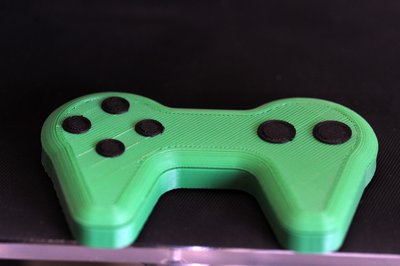Engineers pave the way towards 3D printing of personal electronics
Scientists are developing materials which could one day allow people to print out custom-designed personal electronics such as games controllers which perfectly fit their hand shape.
The University of Warwick researchers have created a simple and inexpensive conductive plastic composite that can be used to produce electronic devices using the latest generation of low-cost 3D printers designed for use by hobbyists and even in the home.
The material, nicknamed ‘carbomorph’, enables users to lay down electronic tracks and sensors as part of a 3D printed structure - allowing the printer to create touch-sensitive areas, for example, which can then be connected to a simple electronic circuit board.
So far the team has used the material to print objects with embedded flex sensors or with touch-sensitive buttons such as computer game controllers or a mug which can tell how full it is.

The next step is to work on printing much more complex structures and electronic components including the wires and cables required to connect the devices to computers.
The research was led by Dr Simon Leigh in the School of Engineering at the University of Warwick.
Dr Leigh said: “It’s always great seeing the complex and intricate models of devices such as mobile phones or television remote controls that can be produced with 3D printing, but that’s it, they are invariably models that don’t really function.
“We set about trying to find a way in which we could actually print out a functioning electronic device from a 3D printer.
“In the long term, this technology could revolutionise the way we produce the world around us, making products such as personal electronics a lot more individualised and unique, and in the process reducing electronic waste.
“Designers could also use it to understand better how people tactilely interact with products by monitoring sensors embedded into objects.
“However, in the short term I can see this technology having a major impact in the educational sector, for example, allowing the next generation of young engineers to get hands-on experience of using advanced manufacturing technology to design fairly high-tech devices and products right there in the classroom.”
The printed sensors can be monitored using existing open-source electronics and freely available programming libraries.
A major advantage of using 3D printing is that sockets for connection to equipment such as interface electronics can be printed out instead of connected using conductive glues or paints.
This research is detailed in the study ‘A simple, low-cost conductive composite material for 3D printing of electronic sensors’, published in the open-access journal PLOS ONE.
Terahertz wave control for enhanced wireless technology
Researchers have developed a new patterned spintronic emitter that enables room-temperature...
Upcycling battery waste and CO2 into fuel
Researchers from TU Wien have produced a nanocatalyst based on spent batteries and aluminium foil...
Evaluating the commercial viability of sustainable perovskite LEDs
Researchers have discovered that perovskite LEDs have great long-term commercial potential,...





